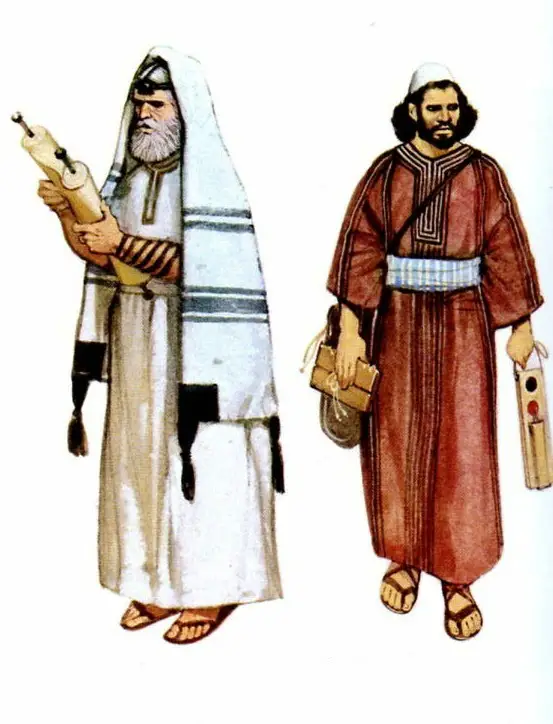Dress in Judaism is distinctive and accepted by many of its adherents, with some garments much more conspicuous than others.

Clothing in Judaism at the time of Jesus.
Looking back to the origins of origins, we are told that God did not seem to pay much attention to this detail at the time of creation. Adam and Eve were naked “and were not ashamed”, according to the book of Genesis (2:25). It was only after the incident with the serpent and the eating of the forbidden fruit (which, according to researchers, was a red tomato and not an apple, a subject for another article) that the first two humans opened their eyes and were surprised to find themselves naked. And so it was that “the Lord God made them clothes of skin”.
Although it is not clear to the exegetes whether they were covered with their own skin or that of another living creature, in a way the clothing ended up being a concession to human weakness. And indeed, beyond the symbolic creation story, clothing played a role in becoming Jewish.
 Clothing has a place in ritual, as well as reflecting religious identification, social status, emotional state and even the Hebrews’ connection to their environment. The Midrash (ancient rabbinic interpretation) teaches that by retaining distinctive clothing during their captivity in ancient Egypt, they maintained their own identity, making them worthy of divine redemption from bondage.
Clothing has a place in ritual, as well as reflecting religious identification, social status, emotional state and even the Hebrews’ connection to their environment. The Midrash (ancient rabbinic interpretation) teaches that by retaining distinctive clothing during their captivity in ancient Egypt, they maintained their own identity, making them worthy of divine redemption from bondage.
Tunic
The tunic was a distinctive garment worn by both men and women that reached down to the feet and was fringed to commemorate the commandments of God’s Law according to the Bible.
Jewish dress
Men’s and women’s clothing differed markedly, but were very similar in general design. There were laws prohibiting the mixing of clothing.
Ancient Hebrew dress would differ between the two sexes in the inner garment (shirt), the outer tunic or garment, the girdle, the outer garment or coat, and the headdress.
Men’s dress
- During religious services they wear a black silk headband called a gartel. On the Sabbath they wear black silk sacks called bekishes, and married men wear fur hats called shtreimel.
- Rabbis dress in black because the Code of Laws states that a Jew’s clothing should not be conspicuous, but should demonstrate humility and modesty.
- During the week, they usually wear long coats in dark colours: black or navy blue, and black hats. Some wear a hat known as a biber hit, which is flat on top and lined with velvet.

Bekishe.
This is a long black coat, which can be made of silk or other material, worn by Hasidic Jews. It is mostly worn on Shabbat and Jewish holidays such as weddings and bar mitzvahs.

Kiphah.
It is the most emblematic sign of the Jewish people. The kippah (plural, kippot) was traditionally worn by Orthodox men. Today, some women, especially those associated with the Reform and Conservative movements, wear the kippah.
While some Jews wear kippot only when praying, reciting a blessing or studying Jewish religious texts, ultra-Orthodox Jews cover themselves with kippot at all times.
The Talmud explains that the Divine presence is on the head and therefore Jews must cover their heads to show respect to Hashem (God). Kippot come in all sizes and designs, for all tastes, situations and fashions. It is not a compulsory item.

Shtreimel Hadishi.
The shtreimel is a hat made of fox fur. It is worn by Hasidic Jews of Polish origin. The “spodik” is very similar to the “shtreimel”, but it is slightly taller and the fur is synthetic.

The tallit.
There are two types of tallit: Katan and Gadol.
TALLIT KATAN
This is an undergarment with four fringes (tzitzit) worn by ultra-Orthodox Jews under their shirts. It is not obligatory and is not worn by all. The garment itself has no religious value and the important thing is the tzitzit (fringes), which are a reminder of the fulfilment of God’s mitzvot (commandments).
It can be made of any material except “shatnez” – a mixture of wool and linen, which is strictly forbidden by the Torah. Most tallit are made of wool.

TALLIT GADOL or PRAYER SHROUD
Another way in which the Orthodox cover their foreheads is through the tallit or prayer shawl, which they wear while reciting their prayers. Many of the tallit are embroidered to indicate that the part of the garment that is placed over the head must always be the same, as it cannot be placed over any other part of the body.
Some Jews usually leave their homes wearing their talit on their way to synagogue. Most prefer to put on their talit when the service begins. Most have their own talit.

Tefillin (FILACTERIAS).
Tefillin or phylacteries consist of two small square leather boxes – made from a kosher animal – attached to long straps. Each box contains four sections of the Torah.
One of the boxes (“the tefillin of the arm”) is placed on the left arm – right if the person is left-handed – seven times around it, so that it faces the heart, which is the place of emotions. The leather strap is wrapped around the left hand and the middle finger of that hand. The other box (the “head tefillin”) is placed on the head, above the forehead, so that it rests on the brain. In this way, attention is drawn to the head, heart and hand. This teaches dedication to the service of God in all that one thinks, feels and does.
Among ultra-Orthodox Jews, tzitzit and tefillin are a constant reminder of Jewish identity in the home, in dress and on the body.

Women’s dress.
Jewish women should dress modestly and neatly, their dress should not be red and their clothes should not be low-cut.
Nowadays there are more opportunities for Jewish women to dress in a variety of blouses, skirts, hats, caps and so on. The use of trousers is forbidden for some Jewish trends, for others it is not, but the idea is that those who approve of their use say that they should be trousers that are not too tight, that do not show the parts of the body or the silhouette of the same, but are “loose”, a neckline does not show the beauty of the woman, showing her parts, only the husband is worthy to see them, appreciate them and enjoy them.

Some have their hair done, some have it painted, some wear neat wigs, some wear Jewish accessories (necklaces, earrings, rings), of which there is also a great variety, they use good make-up.
They have well-groomed hands, a good perfume is always essential, it is all a matter of the woman and how she wants to project herself to people and her husband, who will always like to see his wife well, this helps the relationship a lot because it keeps alive the admiration for her and vice versa.
The dress code of the ultra-Orthodox Jewish woman is dictated by Jewish law and can be defined in one word: “tzniut”, which means modesty. Orthodox women are required to dress conservatively, and the level of modesty expected – in terms of how hair is covered and the appropriate length of skirts, dresses and sleeves – varies from sect to sect.
Depending on which group they belong to, women observe all, some or none of these dress requirements.

Tichel.
The tichel is a headscarf worn by most ultra-conservative married women. Tichels can range from plain cotton to elaborately patterned fabrics.

Other elements
The payot, peyot or side curls
Their origin among ultra-orthodox Jews comes from the biblical interpretation of not shaving the sides of the head. There are different types of payot among different groups of ultra-Orthodox Jews. For example, the Haredim wear their ringlets quite short and tucked behind their ears, the Hasidim wear them long, the Belz Hasidim never cut them and wear them wrapped around their ears, the Yemenites (Yemenite Jews are those who live or lived in Yemen (only a handful remain in Yemen, mostly elderly).
Between June 1949 and September 1950, the vast majority of Yemenites were brought to Israel in an operation called the “Magic Carpet”), let their ringlets grow to their shoulders, etc. (see article: What Judaism is all about).





